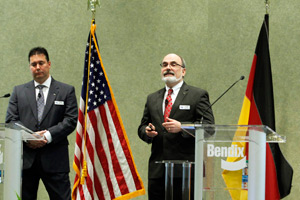NTSB Calls for US to Mandate Collision-Avoidance Systems

This story appears in the June 15 print edition of Transport Topics.
The National Transportation Safety Board called on the federal government to make mandatory the installation of forward-collision-avoidance systems on all new motor vehicles, including large trucks.
The independent board synchronized its recommendation last week with the release of a study showing the systems — already available and in use — can eliminate some accidents and reduce the severity of others, thereby reducing highway fatalities.
The June 8 recommendation came less than one week after the National Highway Traffic Safety Administration acted on an earlier board recommendation and mandated electronic stability control — a related safety system — on all new highway tractors starting in August 2017.
“You don’t pay extra for your seat belt, and you shouldn’t have to pay extra for technology that can help prevent a collision altogether,” NTSB Chairman Christopher Hart said in announcing the recommendation on the radar-based systems. The board has been interested in collision warning or avoidance technology since 1995.
The board’s report said that rear-end crashes cause about 1,700 U.S. deaths and 500,000 injuries each year.
The two major suppliers that make the devices — Bendix Commercial Vehicle Systems and Meritor Wabco — and the truck makers that buy them generally supported the recommendation.
Within trucking, the reaction was mixed.
American Trucking Associations Engineering Director Ted Scott said the federation is “looking very hard” at the proposal, especially because NTSB mentioned all vehicles and not just trucks. Scott said analyzing the fine details on any mandate would be critical.
Virginia Tech is working on a forward-collision study for NHTSA, Scott said, adding that the results of the research will be an important part of ATA’s deliberations.
The University of Michigan Transportation Research Institute studied collision avoidance and mitigation for NHTSA in 2012, and found the systems available then reduced rear-end crashes, fatalities and injuries by 16% to 25%.
Con-way Inc., which ranks No. 4 on the Transport Topics Top 100 list of U.S. and Canadian for-hire carriers, began a major experiment with avoidance and mitigation systems in 2010, said Greg Pawelski, senior director of safety for the less-than-truckload Freight division.
About 5,000 of Freight’s 8,700 Freightliner tractors use Meritor Wabco OnGuard.
“If a truck is following too closely, first it sends an audible warning tone to the driver. Then it assists the driver in slowing down the truck, and it can do this faster than the driver alone can react,” Pawelski said.
Results drove the Freight division to keep buying the systems, and the trend spread to the Truckload unit, too.
“We got the most benefit in rear-end collisions with a 70% reduction,” Pawelski said.
NHTSA does not list forward-collision avoidance among its major regulatory undertakings, but Transportation Secretary Anthony Foxx said in January he wants to pursue automatic emergency braking systems, a key component of collision avoidance and mitigation.
Volvo Group’s two North American operating companies, Volvo and Mack Trucks, have been offering the systems as options since 2009 as part of enhanced cruise control. Using radar and computer module calculations, the device lowers cruise control speed in reaction to surrounding traffic conditions.
Both manufacturers said the option has been gaining in popularity since it was introduced. Volvo also was mentioned in the NTSB report for its efforts.
Navistar Inc., maker of International Trucks, said at a March trucking show that it is offering Wingman Fusion, the latest Bendix avoidance-and-mitigation system, as an option.
“Advanced safety technologies are an area of strong customer interest. We believe forward-collision-avoidance systems can offer safety benefits, and we offer this option on our linehaul tractors,” said Denny Mooney, a Navistar senior vice president.
“Features like lane-departure warning, obstacle detection, collision mitigation, stability control and rollover protection can significantly lower a fleet’s repair cost and continue to make trucks easier to drive,” he said.
Bendix’s Fred Andersky said Wingman Fusion combines traditional radar with cameras to plug a weakness in earlier versions. Radar works best with moving metal objects. Stationary objects don’t register as well, but cameras can pick them up.
“We can see or recognize the image” and merge the information from the two sources, said Andersky, the company’s director of government and industry affairs. Based on discussions with government officials and other manufacturers, Andersky said, he expects an NHTSA regulatory proposal on collision avoidance and mitigation in 2017 or 2018.
Daimler Trucks North America, the parent of Freightliner and Western Star Trucks, still maintains a relationship with Meritor Wabco but also offers a similar system through its in-house Detroit Assurance package.
Todd Spencer, executive vice president of the Owner-Operator Independent Drivers Association, opposed the idea.
“It’s ironic that the NTSB itself was the first to recommend driving training standards decades ago but today all but ignores that crucial need and instead pushes for more technology,” he said.
“Peterbilt offers factory-installed collision-mitigation systems,” said the company’s Anthony Gansle. It has been an option since 2012.
Staff Reporter Eric Miller contributed to this story.




